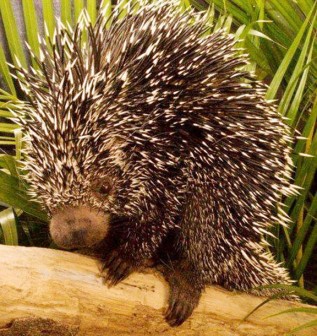The Brazilian Porcupine (Coendou prehensilis) or Porcupine is a spiny, arboreal, nocturnal creature and in the North Rupununi has been noted for having a preference for palm forests.
The Porcupine can be found in Venezuela, the Guianas, Brazil, Bolivia and Trinidad. The IUCN has listed the species of Least Concern as it is believed their populations are stable; they have a wide distribution; can be found in a number of protected areas and adjust quite well to modest moderations in their habitat – tropical forests in elevations from 150 to 1500m. As a result, localised populations may be affected by deforestation.
The Porcupine is arboreal and nocturnal. It is about 300-600 mm in length, half of which is the tail. The top is covered with thick, short spines that range in colour from white or yellow to black. The belly area is grey in colour. The tail is spineless and is prehensile, used by the animal for holding onto the tree when climbing. The feet are adapted for climbing and are equipped with long clawed toes. The lips and nose are fleshy in nature.
![]() Because of its nocturnal activities, the Brazilian Porcupine spends its days resting in trees in the shade. It rarely comes to the ground but will defend itself if attacked or roll itself into a ball if caught. The animal is known to stamp its hind feet when excited and would make short growls and crying vocalisations. The animal feeds mostly on vegetation including fruits, tender shoots, flowers and roots.
Because of its nocturnal activities, the Brazilian Porcupine spends its days resting in trees in the shade. It rarely comes to the ground but will defend itself if attacked or roll itself into a ball if caught. The animal is known to stamp its hind feet when excited and would make short growls and crying vocalisations. The animal feeds mostly on vegetation including fruits, tender shoots, flowers and roots.
Little is known about the mating behaviour and there seems to be no defined breeding season. One young is born to the female after a gestation of 203 days and the young is born with red hair and soft spines which harden after birth. The young can climb almost immediately after birth and is weaned after 10 weeks and reach adult size within a year.

Brazilian Porcupines reach sexual maturity around 19 months. Econo-mically the species can be destructive when they invade farms to feed. They however, are eaten in some parts of South America.
Rain forests are rich in biodiversity and are home to many different plants and animals as well as indigenous communities. Humans, even those who don’t live in the rain forest, rely on it for resources such as building materials (wood and lianas), medicine and fruits. Rain forests also provide essential environ-mental services for life on earth; they create soil as well as prevent soil erosion, produce oxygen though photosynthesis, maintain clean water systems, and are a key defence against climate change.
The Iwokrama Rain Forest is 371,000 hectares, located in the heart of Guyana. Our mission is to develop strategies for conservation and sustainable development for local people in Guyana and the world at large. We are involved in timber, tourism and training. Come and visit us in the rain forest or at http://www.iwokrama.org.









